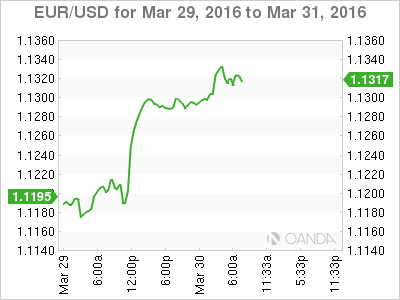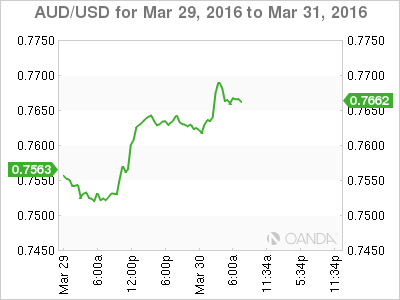Wednesday March 30: Five things the markets are talking about
Prior to Ms. Yellen’s Economic club speech in New York yesterday, the markets were experiencing low volatility, a new market norm since Central Bank guidance came back on line in early March and little to no transactional volume being executed.
Within in a matter of moments the Fed Chair happened to ‘mix it up’ by blindsiding capital markets with her cautious negativity. Many expected Yellen to stick to her “usual” dovish script, but that was not to be the case. The Fed chair has virtually closed the Fed’s door to rate normalization for the foreseeable future.
A quite boring start to a holiday-shortened week has now been turned on its head with renewed apprehension. Investors have yet to be served this week’s main course – Friday’s non-farm payroll (NFP) report.
1. Yellen to remain cautious in rate normalization
Day two of the fallout has European and Asian stocks surging, crude oil rallying as the U.S dollar heads for its worst month in more than five-years.
The market is interpreting Yellen’s remarks from yesterday as overtly dovish, suppressing the more hawkish comments of other recent Fed speakers over the past week. This is penalizing the ‘mighty’ U.S dollar as investors unwind the currency’s rate differential premium, while flattening the U.S yield curve.
While concluding that cautiousness in policy adjustment is the most appropriate course of action by reiterating that the FOMC is not on a preset course for normalizing policy is naturally supporting the global stock rally. But, not all sectors profit – investors should expect the banking sector to lag behind, while other rate-sensitive groups like utilities, homebuilders, and emerging markets to benefit.

2. Dollar down, but is it out?
The EUR is trading higher, straddling the psychological €1.13 level, as we head stateside. Is the ‘big’ dollars weakness to be short-lived? The ECB will formally start its additional +€20B of asset purchases next month as part of the new easing measures – surely that will have an impact on the single currency?
The yen (¥112.32) continues to build upon gains established after Japan’s PM Abe failed to mention any extra stimulus measures for the upcoming fiscal year overnight. The Fed’s dovishness has Emerging Market currencies trading at new multi-month highs against the greenback. The Turkish lira outright (TRY) has risen to its strongest print in more than four-months, peaking this morning at $2.8252, a level not seen since late November. The USD index continues to trade under pressure, down -0.4%.

3. Global bond yields shift
Aussie government debt has lead the charge higher in Australasia, with their 10-Year yields sliding eight basis points to +2.50%. Rates on similar maturing Indian bonds have dropped two basis points to +7.49%.
Elsewhere, Bund yields have rallied one basis point to +0.14%, while the yields on U.S. 10-Year Treasuries are up one basis point at +1.82% – they both respectfully fell in yesterday’s afternoon session with U.S 10’s declining by -7bps to a new one-month low of +1.81%.
Yellen’s hesitance to raise rates is pushing investors to unwind the U.S flattening-curve trade (this trade has dominated fixed income markets for the past two-years). Dealers are selling long-term bonds and buying back short-term debt – 2’s 10 spreads has widened to +1.02% from Monday’s +1.0%.

4. Brexit Polls
In the wake of the Belgium bombings last week, the latest Brexit BMG poll has shifted. The latest figures announced has +41% for staying in EU, +45% for leaving and +14% undecided. Previously it was 40/40/20.
Dealers and investors have been trying to gage the best way to hedge for Brexit. Thus far, it seems that the consensus is looking to short the EUR, believing its a cheaper way to hedge Brexit than shorting sterling outright. Why? Analysts believe that the single unit is “underpricing” the potential economic disruption related to Brexit and shorting EUR/USD is a cheaper way than shorting GBP/USD to hedge for such a possibility. Fed Chair Yellen is certainly giving the EUR bear food for thought and perhaps a cheaper opportunity to hedge Brexit fallout.

5. ADP Report
Market eyes will be front and center for this morning’s NFP dry run. Data from the ADP Research Institute (newly employed ex-farming industry and government) is expected to show an increase of +195k jobs for March. The private report is watched as an indicator of the non-farm payroll release due this Friday. This data is designed to mimic, but not always a strong correlation with NFP. Nevertheless, it remains highly regarded and could sway a few analysts if there is a surprise.
